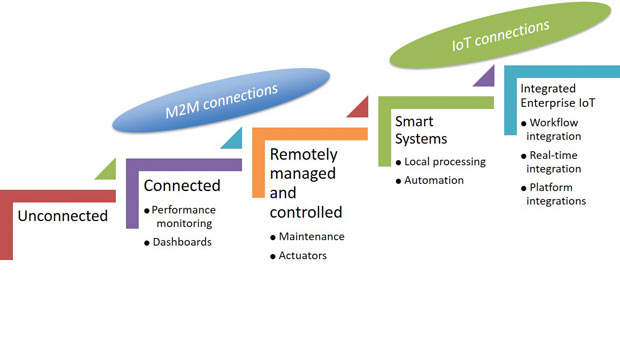February 1, 2016
 Enterprise IoT has emerged as a highly disruptive and transformational development for most industries. Enterprise IoT is all about smarter, connected industrial devices and products, capturing, sharing and processing data about the environment, and integrating this processed information in enterprise architectures and systems with the aim of producing real-time actionable insights and ultimately automated responses.[1]
Enterprise IoT has emerged as a highly disruptive and transformational development for most industries. Enterprise IoT is all about smarter, connected industrial devices and products, capturing, sharing and processing data about the environment, and integrating this processed information in enterprise architectures and systems with the aim of producing real-time actionable insights and ultimately automated responses.[1]
Looking back, machine-to-machine (M2M) connections have predominantly been implemented by operational departments in enterprises. Through these connected sensors, operational performance could be monitored and managed. In IoT, this level of “connectedness,” as illustrated in Fig. 1, extended from operational environments to include other forms of products such security systems, asset tracking devices, manufacturing tools, thermostats and/or field force solutions.
The scope has, unsurprisingly, moved from mainly operations to other key departments and business units such as product design, customer services and marketing. IoT, through continuous data connections, provides product designers with a host of new and exciting product and service innovations including:
• new product design process capabilities with augmented reality technologies;
• continuous monitoring of the usage, condition and quality of products;
• immediate product feedback;
• new pricing models and new value added service models;
• enhanced product and service lifecycle management; and
• closer interaction with end users.
Let’s look in greater detail at several of these.
 Fig. 1: From M2M to IoT connections: characteristics at each technology step. Image courtesy of Machina Research.
Fig. 1: From M2M to IoT connections: characteristics at each technology step. Image courtesy of Machina Research.New Product Design Process Capabilities
Product designers will be acquainted with designing products with CAD solutions. Through these time-saving and highly flexible software tools, product designers have been able to create virtual prototypes, or at least define the necessary build of materials to complete the product. With IoT, this process remains the same but where the CAD solution stopped—and the physical product became a reality—we are now witnessing the next stage in product design.
Having “designed” the product virtually, it now goes into production as well as having a digital twin created for every single physical product. This digital twin, connected to its physical twin through IoT connections, provides real-time information about the usage, condition and quality of the product, and may be monitored, analyzed and acted upon by product designers as soon as the product has been activated.
Optimizing this real-time feedback of information, product designers are further able to enhance the analysis and interpretation of this data. One example is the adoption of augmented reality technologies that combine the digital twin (representation) of the physical product with augmented data information visually adhered to the product.[2] Fig. 2 illustrates the use of augmented reality technology on a physical product.
The opportunities from this connected product design space remain substantial. From immediate product feedback enabling enterprises to improve product design based on actual end-user usage, to identifying and addressing product faults before requiring significant product recall routines. Further enhanced with predictive analytics tools such as predictive maintenance, product designers as well as their customer service and operational colleagues will identify new and exciting opportunities from Enterprise IoT.
Exploring New Pricing Models and Value Added Service Models
As Enterprise IoT opens these new opportunities for product designers in the “physical” and design process sense, Enterprise IoT further enables a host of new possibilities in terms of pricing models and creating new services.
With real-time usage and condition information constantly available to manufacturers, products may be sold as services—priced on the basis of usage and condition of the product, and ultimately managed with reduced downtime, higher performance and improved safety parameters (through constant product monitoring). There may be new opportunities for more detailed and part specific warranty management, or for new trade-in models based on detailed condition management systems.
Enhanced Product and Service Lifecycle Management
And finally, with Enterprise IoT, product design needs to become a significantly more open and dynamic process, combining hardware and software. In hardware product design, improvements or replacements of models are key. In software product design, enabling updates and fixes are key. In Enterprise IoT with connected products, these two design processes will need to be combined. Traditional product designers will need to look at and plan for the extended lifecycles of the products and the associated services, and one of the most interesting developments with Enterprise IoT will be this merger of hardware and software designers.
Enterprise IoT is a disruptive technology and market force. Connected products with services are transforming industries and changing markets. Enterprises are actively going down this road, and product designers standing still or turning their backs on this transformation will find it challenging, if not impossible, to compete with this “next wave.”
Resources:
[1] For more information about Enterprise IoT, read Machina Research Strategy Report “Defining and Implementing Your Enterprise IoT Strategy”
[2] For a more detailed example of this new development of digital twins, see Machina Research’s Research Note on “Digital Twins Bring IoT Full Circle Within Manufacturing Design”
Subscribe to our FREE magazine, FREE email newsletters or both!
About the Author
Emil BerthelsenEmil Berthelsen is a principal analyst at Machina Research, leading the Enterprise IoT stream, and focuses on Big Data, data analytics, M2M and IoT Platforms and SLAs.
Follow DE






